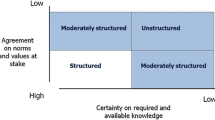Abstract
This article presents an overview of the sustainability initiatives at the St. John's campus of Memorial University in Newfoundland and Labrador (Canada). The key initiatives include setting a realistic goal for energy efficiency, becoming carbon neutral, and conducting various research and outreach projects related to sustainability. As sustainability initiatives are relatively new, many recommendations have been made including: the integration of sustainability efforts across campus and lobbying networks in the Atlantic Region with other institutions and to leverage currents assets into further opportunities for research, teaching and institutional development in the Atlantic Region. For developing a more robust and integrated decision-making, a tool based on driving force-pressure-state-exposure-effect-action framework and multi-bottom line approach is introduced. Various aspects of this framework are demonstrated through examples.





Similar content being viewed by others
References
AASHE. (2011) Sustainability Tracking, Assessment and Rating System (STARS), available at https://stars.aashe.org/, accessed 20 July 2011.
Alshuwaikhat, H.M. and Abubakar, I. (2008) ‘An integrated approach to achieving campus sustainability: assessment of the current campus environmental management practices’, Journal of Cleaner Production 16 (16): 1711–1822.
Barnes, P. and Jerman, P. (2002) ‘Developing an environmental management system for a multiple-university consortium’, Journal of Cleaner Production 10 (1): 34.
Barth, M., Godemann, J., Rieckmann, M. and Stoltenberg, U. (2007) ‘Developing key competencies for sustainable development in higher education’, International Journal of Sustainability for Higher Education 8 (4): 416–430.
Belton, V. and Stewart, T. (2002) Multiple Criteria Decision Analysis: An Integrated Approach, Boston, MA: Kluwer Academic Publishers.
Beringer, A., Wright, T. and Malone, L. (2008) ‘Sustainability in higher education in Atlantic Canada’, International Journal of Sustainability in Higher Education 9 (1): 48–67.
Clarke, A. and Kouri, R. (2009) ‘Choosing an appropriate university or college environmental management system’, Journal of Cleaner Production 17: 971–984.
Cole, L. (2003) Assessing Sustainability on Canadian University Campuses: Development of a Campus Sustainability Assessment Framework, Canada: Royal Roads University.
Corvalán, C.F., Kjellström, T. and Smith, K.R. (1999) ‘Health, environment and sustainable development: identifying links and indicators to promote action’, Epidemiology 10 (5): 656–660.
DSD. (1992) ‘Agenda 21’, The United Nations Programme of Action from Rio, United Nations Division for sustainable Development, available at DSD http://www.un.org/esa/dsd/agenda21/.
Green Report Card. (2010) Green Report Card for 2011, available at http://www.greenreportcard.org, accessed May 2011.
IUCN. (2011) Environmental Accounting: What's It All About? available at http://www.unpei.org/PDF/budgetingfinancing/Environmental-accounting.pdf.
Loucks, D.P., Stakhiv, E.Z. and Martin, L.R. (2000) ‘Sustainable water resources management’, Journal of Water Resources Planning and Management 126: 43–47.
Lozano, R. (2006) ‘Incorporation and institutionalization of SD into universities: breaking through barriers to change’, Journal of Cleaner Production 14 (3): 786–796.
McLeans. (2011) University Rankings 2010, available at http://www2.macleans.ca/2010/11/10/university-rankings/.
MUN. (2008) MUN Strategic Planning 2008–2012, available at http://www.mun.ca/strategicplanning/StrategicReport5Pillars.pdf, accessed 22 July 2011.
MUN. (2010) The Shining research stars 2010, available at http://www.mun.ca/research/2010report/.
MUN. (2011a) Fact Book 2010, http://www.mun.ca/ciap/Analysis/FACT_BOOK_2010.pdf, accessed May 2011.
MUN. (2011b) MUN Sustainability Office, available at http://www.mun.ca/sustain/sustainability_office/.
Niemeijer, D. and de Groot, R. (2008) ‘Framing environmental indicators: moving from causal chains to causal networks’, Environmental Development in Sustainability 10: 89–106.
OECD. (2010) Roundtable on Higher Education in Regional and City Development, 15–16 September 2010 Paris: OECD Conference Centre, available at www.oecd.org/edu/imhe/regional/roundtabled.
Shriberg, M. (2002) ‘Institutional assessment tools for sustainability in higher education: strengths, weaknesses, and implications for practice and theory’, International Journal of Sustainability in Higher Education 3 (3): 254–270.
Singh, R.S., Murty, H.R., Gupta, S.K. and Dikshit, A.K. (2009) ‘An overview of sustainability assessment methodologies’, Ecological Indicators 9: 189–212.
ULSF. (1990) The Talloires Declaration, Talloires, France: UNESCO.
UN. (1992) ‘Report of the United Nations Conference on Environmental and Development’, Rio de Janeiro, 3–14 June.
UNESCO. (1993a) ‘Kyoto declaration’, The 9th Round Table Meeting of IAU, Kyoto, Japan: UNESCO, available at www.unesco.org/iau/sd/sd_dkyoto.html, accessed May 2011.
UNESCO. (1993b) The Swansea Declaration, UNESCO, Wales: Swansea Publishing, available at http://www.iisd.org/educate/declarat/swansea.htm.
Waheed, B., Khan, F. and Veitch, B. (2011a) ‘Developing a quantitative tool for sustainability assessment of HEIs’, International Journal of Sustainability in Higher Education 12 (4): In Press.
Waheed, B., Khan, F., Veitch, B. and Hawboldt, K. (2011b) ‘Uncertainty-based quantitative assessment of sustainability for higher education institutions’, Journal of Cleaner Production 19 (7): 720–732.
Waheed, B., Khan, F.I., Veitch, B. and Hawboldt, K. (2011c) Ranking Canadian Universities: A Quantitative Approach for Sustainability Assessment using uD-SiM, International Journal of Sustainable Engineering (under review).
WHO. (1996) Linkage Methods for Environment and Health Analysis: General Guidelines, (WHO/EHG/95.26), Geneva, Switzerland: WHO, available at http://markstat.net/en/images/stories/who_publications.pdf, accessed 2 August 2011.
Acknowledgements
The authors would like to thank Dr Rehan Sadiq for his valuable suggestions and thought-provoking discussions in the preparation of this manuscript.
Author information
Authors and Affiliations
Rights and permissions
About this article
Cite this article
Waheed, B., Khan, F., Veitch, B. et al. An Integrated Decision-Making Framework for Sustainability Assessment: A Case Study of Memorial University. High Educ Policy 24, 481–498 (2011). https://doi.org/10.1057/hep.2011.17
Published:
Issue Date:
DOI: https://doi.org/10.1057/hep.2011.17




